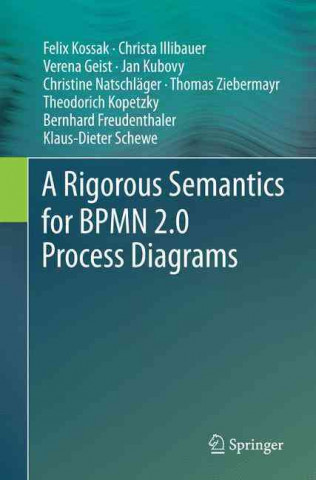
Doručenie
Nákupný poradca





Nehodí sa? Žiadny problém! U nás môžete do 30 dní vrátiť
 Darčekový poukaz
v ľubovoľnej hodnote
Darčekový poukaz
v ľubovoľnej hodnote
S darčekovým poukazom nešliapnete vedľa. Obdarovaný si za darčekový poukaz môže vybrať čokoľvek z našej ponuky.
Rigorous Semantics for BPMN 2.0 Process Diagrams
 Angličtina
Angličtina
 137 b
137 b
30 dní na vrátenie tovaru
Mohlo by vás tiež zaujímať


This book provides the most complete formal specification of the semantics of the Business Process Model and Notation 2.0 standard (BPMN) available to date, in a style that is easily understandable for a wide range of readers - not only for experts in formal methods, but e.g. also for developers of modeling tools, software architects, or graduate students specializing in business process management. BPMN - issued by the Object Management Group - is a widely used standard for business process modeling. However, major drawbacks of BPMN include its limited support for organizational modeling, its only implicit expression of modalities, and its lack of integrated user interaction and data modeling. Further, in many cases the syntactical and, in particular, semantic definitions of BPMN are inaccurate, incomplete or inconsistent. The book addresses concrete issues concerning the execution semantics of business processes and provides a formal definition of BPMN process diagrams, which can serve as a sound basis for further extensions, i.e., in the form of horizontal refinements of the core language. To this end, the Abstract State Machine (ASMs) method is used to formalize the semantics of BPMN. ASMs have demonstrated their value in various domains, e.g. specifying the semantics of programming or modeling languages, verifying the specification of the Java Virtual Machine, or formalizing the ITIL change management process. This kind of improvement promotes more consistency in the interpretation of comprehensive models, as well as real exchangeability of models between different tools. In the outlook at the end of the book, the authors conclude with proposing extensions that address actor modeling (including an intuitive way to denote permissions and obligations), integration of user-centric views, a refined communication concept, and data integration.
Informácie o knihe
 Angličtina
Angličtina




 Ako nakupovať
Ako nakupovať





































